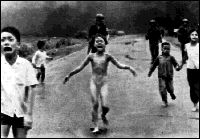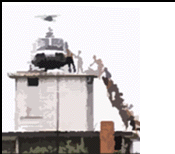|
Vietnam Veterans FactsVietnam veterans are unique as the only group of combat veterans in the history of this great country who returned home to be reviled, vilified and abused rather than honored and appreciated. They are one of the most unjustly-maligned groups in American history. Numerous myths (that's a polite word for lies), some caused by inaccurate media reporting, many simply made up by anti-war activists to suit their purposes, have shadowed these vets for 40+ years. Unfortunately, these lies have been repeated often enough that many people now accept them at face value. Generations of Americans, too young to remember, need to learn the truth about these fine and heroic men and women. So we're here to dispel some of those myths. is more misunderstood than the Vietnam War. It was misreported then, and it is misremembered now. ---Richard M. Nixon  Let us understand: North Vietnam cannot defeat or humiliate the United States. Only Americans can do that. ---Richard M. Nixon These men and women answered their nation's call, to protect the world from the spread of communism. Some were drafted, many more volunteered to serve in a cause in which they believed. Those who came home left their youth and innocence in Southeast Asia. Many are still haunted by the things they experienced there. Many did not return -- more than 58,000 names of U.S. service members killed in Vietnam are carved into slabs of black granite that form the Vietnam War Memorial (known simply as "The Wall") in Washington, DC. Many things are still not understood about our government's management of the conflict, and many things are misunderstood. The least understood facet is why it seemed as though those in power were making our troops fight basically with one hand tied behind them, restricting targets and snatching defeat from the jaws of victory. Fighter pilots were not allowed to bomb certain targets, some considered "high-value" targets, and couldn't understand why. No one could understand why it seemed our government wanted our troops to lose the war. If that was the case, why send them in the first place? And something many people don't understand is that there had been a constant U.S. military presence (as advisors) in Vietnam since 1945. without any censorship. Without censorship, things can get terribly confused in the public mind. --- General William Westmoreland  into the comfort of the living room. Vietnam was lost in the living rooms of America - not on the battlefields of Vietnam. --- Marshall McLuhan, 1975  Because the war was politically unpopular, and unfiltered images played out on American television, sometimes incorrectly described, there was a groundswell of opposition to the war and to the American administration's policies. Protests on college campuses were large and frequent, and frequently became unruly. The first draft card burning took place at a protest on the campus at UC Berkeley. At the 1968 Democratic National Convention in Chicago, anti-war protesters marched and demonstrated throughout the city. Tensions between police and protesters quickly escalated, resulting in a "police riot". Because of the widespread opposition to the war, and the strong passions ignited by anti-war activists, our veterans were grossly mistreated when they returned home. They could not wear their uniforms off base for their own safety, they were spit upon in public places, and one of the many epithets hurled at them was "baby killer." Even in the Pentagon, military service members only wore uniforms one day a week. Those who opposed the war went to great lengths to demonize our Vietnam vets, who weren't responsible for the government's policy, but merely carried it out. They didn't (and still don't) understand why they were treated like criminals after honorably serving their country. For four decades these men have been vilifed by some factions of the public. These vets are still treated with contempt in some circles, and the false stereotype continues to be repeated, often innocently. It's time to educate the American public about our Vietnam vets. of thousands of newspaper and magazine articles, hundreds of books, and scores of movies and television documentaries. The great majority of these efforts have erroneously portrayed many myths about the Vietnam War as being facts. --- Richard M. Nixon For those too young to remember the truth, the lies have been repeated so often, they're generally accepted as the truth. Vietnam vets have vowed, "Never again will U.S. veterans be treated the way we were." It is largely due to their efforts that today's Iraq and Afghanistan vets are being treated with more respect and recognized for the sacrifices they make on our behalf. We recently had a discussion among some readers about the demographics of Vietnam vets, with some readers repeating inaccurate information found online. So we've done a little more research, and we'd like to thank the Vietnam Helicopter Pilots Association webmaster Gary Roush for giving us permission to reprint some of the statistics posted on their site, which are well-documented as to source.  Ready to do some myth-busting? Here we go: MYTH: The United States lost the war in Vietnam Reality: The American military was not defeated in Vietnam. The American military did not lose a battle of any consequence. From a military standpoint, it was almost an unprecedented performance. (Westmoreland quoting Douglas Pike, a professor at the University of California, Berkeley, a renowned expert on the Vietnam War) [Westmoreland] This included the Tet Offensive in 1968, which was a major military defeat for the VC (Viet Cong) and NVA (North Vietnamese Army). THE UNITED STATES DID NOT LOSE THE WAR IN VIETNAM, THE SOUTH VIETNAMESE DID -- after the U.S. Congress cut off funding. The South Vietnamese ran out of fuel, ammunition and other supplies because of a lack of support from our Congress, while the North Vietnamese were very well supplied by China and the Soviet Union. And those who lived through that experience don't want to see the same things happen in Iraq if we pull our troops out too soon, before the Iraqi people have created a stable situation in their country and are capable of defending themselves. MYTH: Most Vietnam veterans were drafted. Reality: Two-thirds of the men who served in Vietnam were volunteers. In contrast, two-thirds of the men who served in World War II were drafted. [Westmoreland] Approximately 70% of those killed were volunteers. [McCaffrey] Many men volunteered for the draft, so even some of the draftees were actually volunteers. MYTH: A disproportionate number of blacks were killed in the Vietnam War. Reality: 86% of the men who died in Vietnam were Caucasians, 12.5% were black, 1.2% were other races. (CACF and Westmoreland) Sociologists Charles C. Moskos and John Sibley Butler, in their book "All That We Can Be," said they analyzed the claim that blacks were used like cannon fodder during Vietnam "and can report definitely that this charge is untrue. Black fatalities amounted to 12 percent of all Americans killed in Southeast Asia - a figure proportional to the number of blacks in the U.S. population at the time and slightly lower than the proportion of blacks in the Army at the close of the war." [All That We Can Be] MYTH: The war was fought largely by the poor and uneducated. Reality: Servicemen who went to Vietnam from well-to-do areas had a slightly elevated risk of dying because they were more likely to be pilots or infantry officers. Vietnam Veterans were the best educated forces our nation had ever sent into combat. 79% had a high school education or better. [McCaffrey] MYTH: The average age of an infantryman fighting in Vietnam was 19. Assuming KIAs accurately represented age groups serving in Vietnam, the average age of an infantryman (MOS 11B) serving in Vietnam being 19 years old is a myth - it is actually 22. None of the enlisted grades have an average age of less than 20. [CACF] The average man who fought in World War II was 26 years of age. [Westmoreland] MYTH: The fighting in Vietnam was not as intense as in World War II. The average infantryman in the South Pacific during World War II saw about 40 days of combat in four years. The average infantryman in Vietnam saw about 240 days of combat in one year thanks to the mobility of the helicopter. One out of every 10 Americans who served in Vietnam was a casualty. 58,169 were killed and 304,000 wounded out of 2.59 million who served. Although the percent who died is similar to other wars, amputations or crippling wounds were 300 percent higher than in World War II. 75,000 Vietnam veterans are severely disabled. [McCaffrey] MEDEVAC helicopters flew nearly 500,000 missions. Over 900,000 patients were airlifted (nearly half were American). The average time lapse between wounding to hospitalization was less than one hour. As a result, less than one percent of all Americans wounded who survived the first 24 hours died. [VHPA 1993] The helicopter provided unprecedented mobility. Without the helicopter it would have taken three times as many troops to secure the 800 mile border with Cambodia and Laos (the politicians thought the Geneva Conventions of 1954 and the Geneva Accords of 1962 would secure the border) [Westmoreland] The Definitive Photo of the Vietnam War MYTH: Kim Phuc, the little nine-year-old Vietnamese girl running naked from the napalm strike near Trang Bang on 8 June 1972, was burned by Americans bombing the area.
In fact, there were no Americans involved in this incident near Trang Bang that burned Phan Thi Kim Phuc. The planes doing the bombing near the village were VNAF (Vietnam Air Force), flown by Vietnamese pilots, in support of South Vietnamese troops on the ground. The Vietnamese pilot who dropped the napalm in error is currently living in the United States. Even the AP photographer, Nick Ut, who took the picture, was Vietnamese. The incident in the photo took place on the second day of a three-day battle between the North Vietnamese Army (NVA), who occupied the village of Trang Bang, and the ARVN (Army of the Republic of Vietnam) who were trying to force the NVA out of the village. Reports in the news media that an American commander ordered the air strike that burned Kim Phuc are incorrect. There were no Americans involved in any capacity. "We (Americans) had nothing to do with controlling VNAF," according to Lieutenant General (Ret.) James F. Hollingsworth, the Commanding General of TRAC (Third [Military] Regional Assistance Command) at that time. Also, it has been incorrectly reported that two of Kim Phuc's brothers were killed in this incident. They were Kim's cousins, not her brothers. Facts about the Fall of Saigon MYTH: The American military was running for their lives during the fall of Saigon in April 1975.
This famous picture is the property of UPI Corbus-Bettman Photo Agency. It is one of 42 pictures of this helicopter that UPI photographer, Hubert Van Es took on 29 April 1975 from UPI's offices on the top floor of the Saigon Hotel, which was several blocks from the Pittman Apartments. [People] Here are some facts to clear up that poor job of reporting by the news media. It was a "civilian" (Air America) Huey, not Army or Marines. It was NOT the U.S. Embassy. The building is the Pittman Apartments, a 10-story building where the CIA station chief and many of his officers lived. The U.S. Embassy and its helipad were much larger. The platform is the top of the elevator shaft for the building and was not designed as a helipad. [People] The evacuees were Vietnamese, not American military. Two high-ranking Vietnamese were among those evacuated that day to Tan Son Nhut airport, General Tran Van Don and the head of the secret police, Tran Kim Tuyen. Both immigrated to Europe and both have since died. [People] The person who can be seen aiding the refugees was CIA operations officer, Mr. O.B. Harnage, who is now retired in Arizona. The pilots who were flying this helicopter, tail number N4 7004, were Bob Caron, who lives in Florida, and Jack "Pogo" Hunter, who died in 1997. [People] Facts About the End of the War: The fall of Saigon happened on 30 April 1975, two years AFTER the American military left Vietnam. The last American troops departed in their entirety 29 March 1973. How could we lose a war we had already stopped fighting? We fought to an agreed stalemate. The peace settlement was signed in Paris on 27 January 1973. It called for release of all U.S. prisoners, withdrawal of U.S. forces, limitation of both sides' forces inside South Vietnam and a commitment to peaceful reunification. [1996 Information Please Almanac] The 140,000 evacuees in April 1975 during the fall of Saigon consisted almost entirely of civilians and Vietnamese military, NOT American military running for their lives. [1996 Information Please Almanac] There were almost twice as many casualties in Southeast Asia (primarily Cambodia) the first two years after the fall of Saigon in 1975, as there were during the ten years the U.S. was involved in Vietnam. [1996 Information Please Almanac] MYTH: The domino theory was proved false. The domino theory was accurate. The ASEAN (Association of Southeast Asian Nations) countries, Philippines, Indonesia, Malaysia, Singapore and Thailand stayed free of Communism because of the U.S. commitment to Vietnam. The Indonesians threw the Soviets out in 1966 because of America's commitment in Vietnam. Without that commitment, Communism would have swept all the way to the Malacca Straits that is south of Singapore and of great strategic importance to the free world. If you ask people who live in these countries who won the war in Vietnam, they have a different opinion from the American news media. The Vietnam War was the turning point for stopping the spread of Communism. [Westmoreland] Democracy Catching On - In the wake of the Cold War, democracies are flourishing, with 179 of the world's 192 sovereign states (93%) now electing their legislators, according to the Geneva-based Inter-Parliamentary Union. In the last decade, 69 nations have held multi-party elections for the first time in their histories. Three of the five newest democracies are former Soviet republics: Belarus (where elections were first held in November 1995), Armenia (July 1995) and Kyrgyzstan (February 1995). And two are in Africa: Tanzania (October 1995) and Guinea (June 1995). [Parade Magazine] SOURCES [Parade Magazine] August 18, 1996 page 10. [CACF] (Combat Area Casualty File) November 1993. (The CACF is the basis for the Vietnam Veterans Memorial, i.e. The Wall), Center for Electronic Records, National Archives, Washington, DC [All That We Can Be] All That We Can Be by Charles C. Moskos and John Sibley Butler [Westmoreland] Speech by General William C. Westmoreland before the Third Annual Reunion of the Vietnam Helicopter Pilots Association (VHPA) at the Washington, DC Hilton Hotel on July 5th, 1986 (reproduced in a Vietnam Helicopter Pilots Association Historical Reference Directory Volume 2A) [McCaffrey] Speech by Lt. Gen. Barry R. McCaffrey, (reproduced in the Pentagram, June 4, 1993) assistant to the Chairman of the Joint Chiefs of Staff, to Vietnam veterans and visitors gathered at "The Wall", Memorial Day 1993. [Houk] Testimony by Dr. Houk, Oversight on Post-Traumatic Stress Disorder, 14 July 1988 page 17, Hearing before the Committee on Veterans' Affairs United States Senate one hundredth Congress second session. Also "Estimating the Number of Suicides Among Vietnam Veterans" (Am J Psychiatry 147, 6 June 1990 pages 772-776) [The Wall Street Journal] The Wall Street Journal, 1 June 1996 page A15. [VHPA 1993] Vietnam Helicopter Pilots Association 1993 Membership Directory page 130. [VHPA Databases] Vietnam Helicopter Pilots Association Databases. [1996 Information Please Almanac] 1995 Information Please Almanac Atlas & Yearbook 49th edition, Houghton Mifflin Company, Boston & New York 1996, pages 117, 161 and 292. [Burkett] Stolen Valor: How the Vietnam Generation was Robbed of its Heroes and its History by B.G. Burkett and Glenna Whitley, Verity Press, Inc., Dallas, TX, 1998. Book review. [People.com] Vietnam 25 Years Later, byJoe Treen, People.com, 21 April 2000. Other Statistics • More than 200,000 South Vietnamese troops died • More than a million Vietnamese civilians died • There were more than 6.5 million displaced war refugees Source: The World Almanac and Book of Facts 1998, World Almanac Books, 1997. Return to top of Vietnam Veterans Facts NAM-POWs Set the Record Straight Return to Home Tell Your Vietnam Stories, or
|



 Show any American over age 50 this photo, and ask what it depicts, and the likely answer will be "Americans bombing innocent women and children in Vietnam."
Show any American over age 50 this photo, and ask what it depicts, and the likely answer will be "Americans bombing innocent women and children in Vietnam."  The picture of a Huey helicopter evacuating people from the top of what was described as the U.S. Embassy during the fall of Saigon in the last week of April 1975 helped to create this myth.
The picture of a Huey helicopter evacuating people from the top of what was described as the U.S. Embassy during the fall of Saigon in the last week of April 1975 helped to create this myth.

New! Comments
Join our conversation! Leave me a comment about this page in the box below. If your comment is about another page on this site, please leave your comment on that page, because I have no ability to move it to the correct page. Thanks!